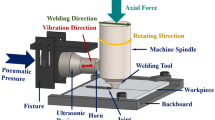Abstract
Ultrasonic metal welding is still an indistinct but useful manufacturing technology. A three-dimensional finite element model was developed to investigate this dynamic welding, including temperature rise, material deformation, and growth of intermetallic compounds. Heat generation at the upper and bottom interfaces, material softening, and high convection boundary conditions was considered. The results show that sonotrode tip teeth penetration starts earlier and increases rapidly, reaching the maximum, but anvil tip penetration starts later and increases slowly. The plastic deformation area of welding zone increases exponentially. Plastic strain is mainly generated in the welding zone, and the total plastic strain of welding zone is approximately proportional to the displacement of sonotrode tip. The thickness of intermetallic layer was dominated by ultrasonic action rather than interface temperature. The model was validated by comparing the predicted temperature, sonotrode displacement, and profile of weld cross section with the experimental results, exhibiting a good agreement.
Similar content being viewed by others
References
Elangovan S, Prakasan K, Jaiganesh V (2010) Optimization of ultrasonic welding parameters for copper to copper joints using design of experiments. Int J Adv Manuf Technol 51(1):163–171
Zhou K, Cai L (2013) Online nugget diameter control system for resistance spot welding. Int J Adv Manuf Technol 68(9–12):2571–2588
Zhou K, Yao P (2018) Simulation of a uniform energy control strategy of single-phase AC resistance spot welding. Int J Adv Manuf Technol 94(5–8):1771–1779
Mohan Raj N, Kumaraswamidhas LA, Nalajam PK, Arungalai Vendan S (2017) Studies on electro mechanical aspects in ultrasonically welded Al/cu joints. Trans Indian Inst Metals 71(1):107–116. https://doi.org/10.1007/s12666-017-1140-8
Zhao Y, Li D, Zhang Y (2013) Effect of welding energy on interface zone of Al–Cu ultrasonic welded joint. Sci Technol Weld Join 18(4):354–360
Satpathy MP, Sahoo SK (2017) Experimental and numerical studies on ultrasonic welding of dissimilar metals. Int J Adv Manuf Technol 1–15
Yang J, Cao B, He X, Luo H (2014) Microstructure evolution and mechanical properties of Cu–Al joints by ultrasonic welding. Sci Technol Weld Join 19(6):500–504
Chen KK, Zhang YS, Wang HZ (2016) Study of plastic deformation and interface friction process for ultrasonic welding. Sci Technol Weld Join 22(3):208–216. https://doi.org/10.1080/13621718.2016.1218601
Ni Z, Ye F (2017) Effect of lap configuration on the microstructure and mechanical properties of dissimilar ultrasonic metal welded copper-aluminum joints. J Mater Process Technol 245:180–192
Siddiq A, Ghassemieh E (2008) Thermomechanical analyses of ultrasonic welding process using thermal and acoustic softening effects. Mech Mater 40(12):982–1000
Elangovan S, Semeer S, Prakasan K (2009) Temperature and stress distribution in ultrasonic metal welding—an FEA-based study. J Mater Process Technol 209(3):1143–1150. https://doi.org/10.1016/j.jmatprotec.2008.03.032
Kim W, Argento A, Grima A, Scholl D, Ward S (2011) Thermo-mechanical analysis of frictional heating in ultrasonic spot welding of aluminium plates. Proc Inst Mech Eng B J Eng Manuf 225(7):1093–1103
Kelly GS, Advani SG, Gillespie JW, Bogetti TA (2013) A model to characterize acoustic softening during ultrasonic consolidation. J Mater Process Technol 213(11):1835–1845
Shen N, Samanta A, Ding H, Cai WW (2016) Simulating microstructure evolution of battery tabs during ultrasonic welding. J Manuf Process 23:306–314
Sasaki T, Watanabe T, Hosokawa Y, Yanagisawa A (2013) Analysis for relative motion in ultrasonic welding of aluminium sheet. Sci Technol Weld Join 18(1):19–24. https://doi.org/10.1179/1362171812y.0000000066
Siddiq A, El Sayed T (2011) Acoustic softening in metals during ultrasonic assisted deformation via CP-FEM. Mater Lett 65(2):356–359
Huang H, Chang B, Du D (2011) Effect of superimposed ultrasound on mechanical properties of copper. Mater Sci Technol 27(7):1117–1122
Hung J-C, Hung C (2005) The influence of ultrasonic-vibration on hot upsetting of aluminum alloy. Ultrasonics 43(8):692–698
Ding Y, Kim J-K (2008) Numerical analysis of ultrasonic wire bonding: part 2. Effects of bonding parameters on temperature rise. Microelectron Reliab 48(1):149–157. https://doi.org/10.1016/j.microrel.2007.01.083
Senouci A, Zaidi H, Frene J, Bouchoucha A, Paulmier D (1999) Damage of surfaces in sliding electrical contact copper/steel. Appl Surf Sci 144:287–291
Soundararajan V, Zekovic S, Kovacevic R (2005) Thermo-mechanical model with adaptive boundary conditions for friction stir welding of Al 6061. Int J Mach Tools Manuf 45(14):1577–1587
Braunovic M, Myshkin NK, Konchits VV (2006) Electrical contacts: fundamentals, applications and technology. CRC press, Boca Raton
Neto DM, Neto P (2012) Numerical modeling of friction stir welding process: a literature review. Int J Adv Manuf Technol 65(1–4):115–126. https://doi.org/10.1007/s00170-012-4154-8
Ngo T-T, Huang J-H, Wang C-C (2015) The BFGS method for estimating the interface temperature and convection coefficient in ultrasonic welding. Int Communi Heat Mass Transfer 69:66–75
Lee D, Cai W (2017) The effect of horn knurl geometry on battery tab ultrasonic welding quality: 2D finite element simulations. J Manuf Process 28:428–441. https://doi.org/10.1016/j.jmapro.2017.04.009
Yang Y, Ram GJ, Stucker B (2009) Bond formation and fiber embedment during ultrasonic consolidation. J Mater Process Technol 209(10):4915–4924
Shin H-S, de Leon M (2015) Parametric study in similar ultrasonic spot welding of A5052-H32 alloy sheets. J Mater Process Technol 224:222–232
Bakavos D, Prangnell P (2010) Mechanisms of joint and microstructure formation in high power ultrasonic spot welding 6111 aluminium automotive sheet. Mater Sci Eng A 527(23):6320–6334
Wang L, Wang Y, Prangnell P, Robson J (2015) Modeling of intermetallic compounds growth between dissimilar metals. Metall Mater Trans A 46(9):4106–4114
Hu T, Zhalehpour S, Gouldstone A, Muftu S, Ando T (2014) A method for the estimation of the interface temperature in ultrasonic joining. Metall Mater Trans A 45(5):2545–2552
Acknowledgements
This research was supported by the National Natural Science Foundation of China (Grant No. 51175184).
Author information
Authors and Affiliations
Corresponding author
Rights and permissions
About this article
Cite this article
Li, H., Cao, B., Liu, J. et al. Modeling of high-power ultrasonic welding of Cu/Al joint. Int J Adv Manuf Technol 97, 833–844 (2018). https://doi.org/10.1007/s00170-018-2002-1
Received:
Accepted:
Published:
Issue Date:
DOI: https://doi.org/10.1007/s00170-018-2002-1




